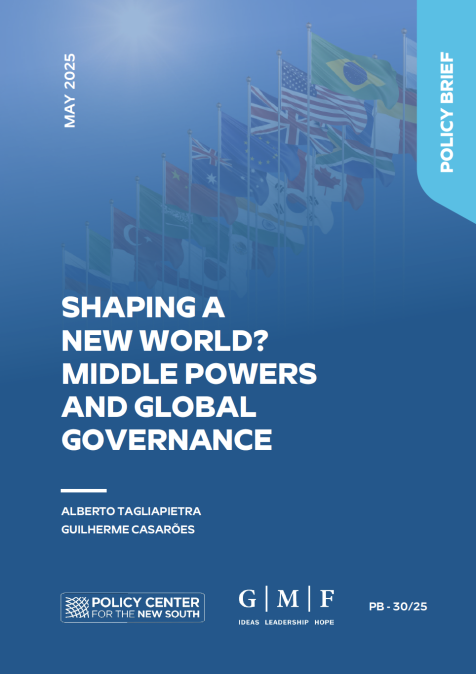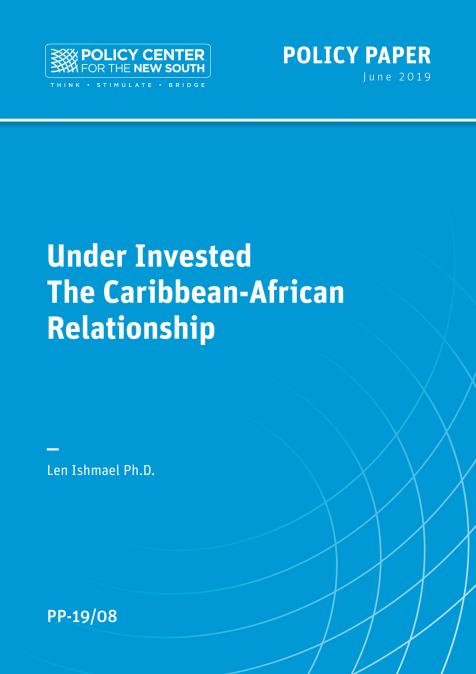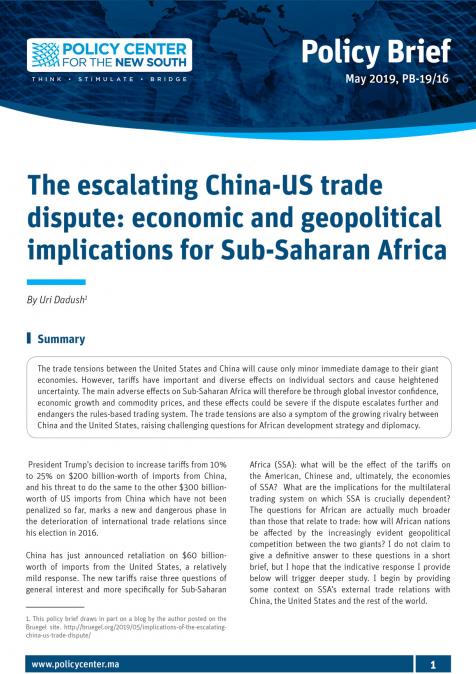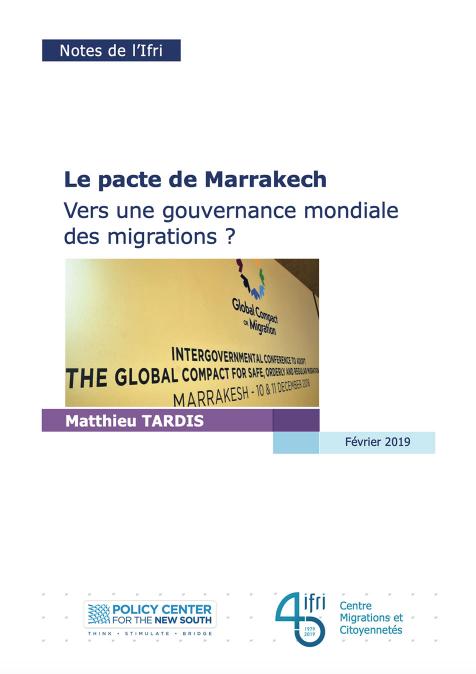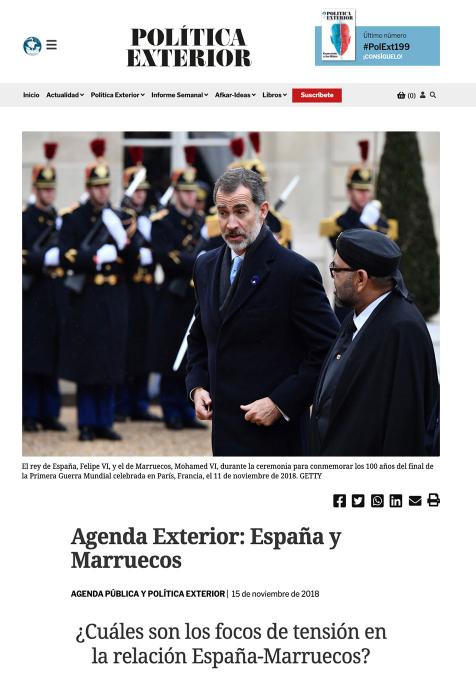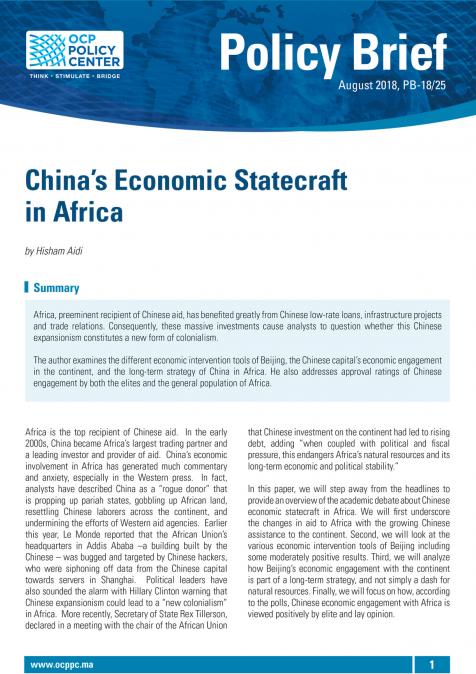Publications /
Policy Brief
Global governance is undergoing a profound transformation, marked by growing polarization, the weakening of multilateral institutions, and the rise of informal, flexible frameworks. As great powers drift from multilateral commitments, and instead prioritize transactional or unilateral actions, middle powers are emerging as key actors in shaping the future of global governance.
These countries, ranging from Brazil and South Africa to Poland, Türkiye, and South Korea, navigate the increasingly fragmented international order by leveraging regional leadership and diplomatic networks, and by participating in ‘minilateral’ coalitions, such as the G20 and the BRICS+. While these actors offer fresh perspectives on how countries might navigate today’s geopolitical landscape, challenges remain. Middle powers have different objectives and capabilities, and limited leverage compared to great powers. These factors risk limiting their potential to act as engines of innovation. While they will be central to shaping the outcome of the current turbulent period, it remains to be seen if they will be able to address the weaknesses of their approach.
In this paper, we explore both the potential of middle powers, and the limitations they face in shaping the evolving international order, taking into consideration the strategies and tools they have at disposal, and the constraints they face.
Introduction
The contemporary geopolitical landscape is characterized by profound shifts, greater polarization, the emergence of new actors, and a resurgence of hard power (both diplomatically and militarily) to settle old conflicts, destabilize neighbors, or gain territory. Multilateralism seems increasingly under pressure. After serving as the agreed paradigm of the last decades, essential rules are being undermined, and recognized institutions are being bypassed. Disruptive events such as the withdrawal of the U.S. from climate cooperation, Russian full-scale aggression towards Ukraine, and the escalation of Israel's war in Gaza, have further weakened the multilateral system. The emergence of clear contradictions, particularly in the form of double standards, has dealt an additional blow to an already fragile landscape. As a result, fewer multilateral treaties are being signed and ratified, the implementation of existing agreements is getting poorer and more contentious, and states are increasingly rejecting oversight of their obligations. Multilateralism finds itself at a crucial crossroads: finally achieving the necessary reforms to confront contemporary challenges and regain public confidence, or giving way to a new era of global governance characterized by regional, informal, and flexible cooperation.
In this context, middle powers—countries that are increasingly relevant in this more multipolar and fragmented system—have a great opportunity to act as the brokers in this turbulent period, being the crucial contributors to the reform of multilateralism or to its phasing-out. But who are these middle powers? These countries are generally characterized by their capacity to influence the outcomes of world politics, or by their tendency to play certain roles, from defending multilateralism to managing conflicts to promoting international rules and norms. Notwithstanding attempts to categorize them, middle powers remain a broad and heterogeneous group, encompassing countries as diverse as Australia, Canada, Norway, and South Korea in the Global North, and Argentina, Brazil, Türkiye, Nigeria, and Indonesia in the Global South. In the next sections, we address the changing landscape of global governance and outline the emerging role in it of middle powers.
The Changing Dynamics of Multilateralism
The post-Second World War liberal international order was shaped through multilateralism, with institutions including the United Nations (UN), the World Trade Organization (WTO), and the International Monetary Fund (IMF) serving as key pillars of global governance. Yet, with the growing number of nation-states, from 51 after 1945 to almost 200 today[1], and the re-emergence of great-power rivalry, multilateral negotiations have become more difficult. The challenges to current institutional arrangements are becoming increasingly complex and, as a result, the global governance architecture is slowly giving way to a more informal, flexible system in which weak ties are favored over formal agreements.
This is exemplified by the fact that over the past three decades, the number of informal intergovernmental organizations rose from 27 to 72, transnational public-private partnerships increased from 26 to 167, and trans-governmental networks expanded from 25 to 141. In the same period, the adoption of multilateral treaties has stagnated. Global governance is going through a crucial phase in which its core mechanisms and institutions are being questioned. In this phase, the growing influence of emerging economies, tensions between the United States and its allies, and increasing great-power competition have given middle powers new leverage in global affairs.
Middle powers enjoy greater strategic maneuverability, their relevance is rising, and major powers are increasingly courting them. However, this situation also brings challenges, particularly as middle powers often have dependencies and vulnerabilities that limit their ability to act. This is particularly relevant when considering that middle powers are a heterogeneous group of countries with different levels of wealth, influence, aspirations, and even priorities. This heterogeneity risks jeopardizing cooperation efforts, and has already played a role in weakening the efforts of middle powers to push for reform of the multilateral system. For example, repeated declarations on the importance of reforming multilateral organizations are made on the margins of BRICS+ summits, without any follow-up in terms of clear, actionable strategies.
On the other hand, Western powers have also been unable to present a convincing and sound plan for reform of the multilateral architecture capable of garnering wide support. The European Union, despite its economic strength, has been unable to produce significant geopolitical influence because of internal divisions and a lack of strategic unity. These conditions have severely undermined its capability to influence a potential reform process. Meanwhile, the U.S. is adopting a heavily transactional approach to international cooperation, significantly weakening global governance and complicating any potential reform attempt, further undermining the credibility and legitimacy of multilateral institutions and frameworks.
In this context, in which none seem willing to take the lead in reforming the current multilateral architecture, global governance seems to be heading toward a minimalist structure, relying on multilateralism only when indispensable, while focusing on smaller-scale initiatives and informal methods to deliver faster results. These dynamics have fueled the rise of less-rigid approaches to solving global challenges, with an increasing relevance for informality, regionalization, and ad-hoc coalitions. While formal international organizations remain influential and relevant, there has been a significant diversification of actors and platforms, particularly to try to bypass the obstacles that increasingly characterize established multilateral institutions. Because of this standstill, middle powers are increasingly securing their interests in informal groupings, and transforming their increasing economic heft into soft power, deepening and expanding their reach.
Examples of this approach are BRICS+ and regional arrangements like the Shanghai Cooperation Organization, which are expanding their memberships and shares of critical global resources, while deepening mechanisms for South-South cooperation. This is also exemplified by the expansion of regional trade (between 2007 and 2023, South-South trade more than doubled from $2.3 trillion to $5.6 trillion), the creation of alternative financial institutions (such as the New Development Bank), and growing cooperation between regional organizations (shown, for example, by the partnership agreement between the New Development Bank and the Asian Development Bank to facilitate cooperation in areas of common interest). All these trends highlight the push towards regional self-reliance, with countries seeking to develop more localized governance frameworks that reflect their unique socio-economic conditions.
This decentralization of global governance suggests a significant change in global politics, marking the shift to a new global ordering architecture. Middle powers are the protagonists in this shift, asserting themself as co-creators of new governance models rather than passive participants in existing frameworks, demanding engagement based on mutual respect and equity. This trend is not simply the reflection of many governments having no say in the creation of the current rules, but also of the perceived selectivity with which the West applies these norms.
While multilateralism is essential for solving global issues, it must be approached pragmatically to ensure it can be instrumental in achieving the best outcome for the global good. The focus should not be on multilateralism for its own sake but rather on whether it can deliver effective solutions to the issues at hand. In the current context, innovation is needed to make multilateralism more representative and efficient, adapting its structures and mechanisms to a changing world. Middle powers have the potential to play pivotal roles in this process.
The Role of Middle Powers in Preserving Multilateralism
It has now become clear that today's major powers—the United States, China, and Russia—are not only steering away from global multilateral commitments and international legal standards, but are to some extent actively trying to undermine them. While selective engagement with multilateralism is not new, words and deeds that place multilateral institutions as enemies, as countering the national interest of the powerful states, have become commonplace among policymakers. On the surface, this situation bears a chilling resemblance to the interwar period of a century ago, when power-hungry statesmen began openly attacking the League of Nations for standing in the way of their expansionist goals. However, there are three main differences between the current crisis and the clash between realists and 'liberal utopians' of the past. First, the multilateral agenda is now much broader and more diverse, built on the realization that there are some global public goods (such as the environment and human rights) that must be preserved collectively. Second, global governance structures are much more complex and institutionalized, having been carefully (and painstakingly) crafted over the last eight decades. Third, and by no means least important, a number of countries are willing to come to the rescue of the rules-based international order.
Against the backdrop of a deepening crisis of multilateralism, middle powers have an increasingly consequential role to play. The relationship between these states and the rules and norms of global governance has a long history, which speaks directly to many of the scholarly definitions of middle powers as defenders of multilateralism. During the early years of the Cold War, middle powers including Australia, Canada, and Sweden were at the heart of multilateral organizations, often punching above their individual weight in order to curtail the capacity of the two superpowers for unilateral action, while advancing the rule of law and a set of basic global principles. Since the 1960s, the rise of newly industrialized middle powers, notably Brazil, Mexico, India, South Africa, and Türkiye, has facilitated new patterns of interaction within the international order, often focused on the needs and demands of the Global South, their emerging alliances (such as the Nonaligned Movement and the G-77), and their relationship with the great powers.
Despite significant differences across generations of middle powers in terms of their size, values, and political institutions, they share common goals and strategies in relation to the international order. Middle powers tend to pursue multilateral solutions to international problems, to embrace positions in international disputes, and to advance the notions of ‘good international citizenship’ to guide their diplomacy. They often compensate for the lack of material capabilities by relying on reputational assets such as diplomatic protagonism in international organizations, conflict mediation, regional leadership, and other forms of soft power. Their common assumption is that a more stable set of global rules and institutions is not only positive for the world, but also for themselves individually, as it provides a framework that limits the leeway of great-power politics and reduces the risks of external shocks.
As for their strategies, middle powers often operate in smaller coalitions. Here, ‘minilateralism’ is not seen as a replacement for multilateralism, but rather a means to exert greater sway and advance better rules for the world. The last three decades have witnessed the proliferation of formal and informal groupings, led by middle powers, to reform and improve some key aspects of global governance. Debates on Security Council enlargement have been spearheaded by the G4, a group that brought together Brazil, Germany, India, and Japan. Coalitions such as BASIC (Brazil, South Africa, India, and China) have been pivotal in sustaining global environmental commitments made from Rio to Kyoto to Paris. When the BRICS (Brazil, Russia, India, China) was established in the mid-2000s, its main goal was to increase middle-power influence in the Bretton Woods institutions. The IBSA (India, Brazil, South Africa) Forum has become one of the leading promoters of South-South technical cooperation in partnership with the UN. Even though this is not an exhaustive list, it reveals the breadth of issues some pivotal middle powers have embraced, in order to improve and strengthen international institutions.
Minilateral strategies are implemented alongside the attempts of middle powers to secure regional influence, or even leadership. Over the last two decades, Türkiye's growing presence in Middle Eastern affairs has turned it into a mediator in talks between Israel and Syria and, more recently, between Israel and Hamas in the context of the Gaza war. Brazilian leadership in the South American integration architecture (particularly in Mercosur and Unasur) has allowed Brazil to exert leadership in mitigating regional crises in Bolivia and along the Colombian-Venezuelan border. India has adopted a 'neighborhood first' approach to South Asia, in order to bring together smaller partners around trade, connectivity, and peace. Indonesia, in turn, has an even longer track record of mediating regional crises through ASEAN, from the Cambodia-Vietnam war in the 1980s to the Myanmar crisis in 2021. Of course, the regional strategies of middle powers have faced several setbacks and not all have produced long-lasting results. Yet it is fair to assume that regions may serve as launching pads for middle powers to exert greater global influence.
Why, then, have middle powers been unable to help multilateralism and global governance overcome contemporary setbacks? One of the most compelling explanations lies in what has been defined as the 'middle-power trap’. According to this concept, the international system is the manifestation of a set of rules and decision-making practices agreed by the hegemonic actors. The hegemons, in order to preserve the order in which they act, coordinate actions, from stigmatization to sanctions, against any actors that try to promote change. In the post-war liberal international order, middle powers have tried to preserve the foundations of global governance through a two-pronged strategy: by acting as diligent ‘rule-promoters’ and occasional ‘rule-makers’. Whenever multilateralism reached a standstill and failed to provide solutions for the world’s problems, middle powers would work to break the deadlock and bring institutions back to functioning. However, many of the challenges faced by global governance today are connected to the structural dimension of international hierarchies, or, the rules and decision-making practices established by the major actors. The United States, China, and sometimes the European Union have blocked, for varying reasons, advancements in areas ranging from Security Council reform to global economic governance. As a result, middle powers that pushed hardest for reform have been called revisionist players, or ‘rule-spoilers’, with the risk of eroding the reputational assets that enabled them to secure multilateralism in the first place.
This is why middle powers have recently turned their eyes to the G20. When the group evolved into a summit of heads of state and government in 2009, it still was centered on the power—and shortcomings—of the world’s wealthiest economies, which had been hit directly by the financial crisis. But since then, the G20 has become a platform for middle powers not just to promote their national strategic agendas, but also to reverse the downward trend of global governance. At the helm of the G20 presidency, Saudi Arabia, Indonesia, India, and Brazil have embraced similar positions on global governance reform, reducing inequality, fighting climate change, and advocating for energy transition. These positions are often combined with bolder, soft-revisionist rhetoric at the United Nations General Assembly. Brazilian president Lula’s speech at the 2024 UNGA, and his administration’s diplomatic efforts at the Rio G20 Summit—which produced a declaration that openly addressed climate change, poverty reduction, and global governance reform—are testaments to how middle powers continue to battle to prevent the collapse of multilateral norms, regimes, and institutions. The recent inclusion of the African Union in the G20, along with emerging partnerships between the grouping and regional actors including ASEAN and Mercosur, might provide a constructive bridge between multilateralism and regionalism, with middle powers as strategic and increasingly consequential hubs.
Middle-Power Activism and the Future of Global Governance
Two main trends characterize current shifts in global governance. First, the already mentioned decline of rigid, multilateral, institutional arrangements favors more flexible, issue-based, minilateral coalitions. Second, there is a slow but ongoing reduction in the demographic, economic, and military shares of the major powers. This is exemplified by the fact that in 1950, the U.S. and its major allies (NATO countries, Australia, Japan), and the communist bloc (Soviet Union, China, Eastern Bloc) accounted for 88% of global GDP. Today, this same group of countries accounts for 57%.
Despite the common invocations that we are at the dawn of a new multipolar world, the overall picture of whether the world is transitioning to multipolarity or something else is still to be settled. While the U.S. and China are still the two most relevant poles of the system (their military expenditures in 2023 amounted to $1.2 trillion[2], and their GDP added up to $44 trillion, almost 43% of global GDP that year), it is not possible to overlook the fact that power is moving to an expanding number of middle powers that are bound to play a growing role in global governance. For example, in 1970 the combined military spending of Nigeria, South Africa, Argentina, Brazil, Australia, India, Japan, South Korea, and Türkiye totaled $23 billion[3], while in 2023 it totaled $377 billion.
The current trend seems to point toward a period of unchecked multipolarity, in which the two major powers will retain a major role in the system while being closely followed by a number of middle powers uninterested in a bipolar stand-off and determined to chart an independent course. Unlike Cold War‘s nonaligned movement, many of today’s middle powers do not reject alignment per se, but pursue multi-alignment on specific issues, trying to diversify their partnerships. Taking advantage of existing institutional infrastructures, and through their consistent presence across global platforms, they have the potential to bridge the growing divide that characterizes global governance, influencing and calibrating the course of international norms, being crucial engines to push for innovation in global governance.
As previously mentioned, middle powers already have a successful history in blueprinting governance strategies, building on their transversal networks to achieve collaborative international engagement, a different approach from the contested one that usually characterizes major powers. In the current situation, there is potential to scale-up this collaborative approach further, making it a stronger tool in the current global-governance toolbox. It can in fact play an essential role in gathering the necessary consensus to circumvent obstacles to multilateral cooperation, having the potential capability to innovate and shape how global governance works. Examples of this potential can already be observed in fields including security, trade, and climate, in which middle powers have long invested energy and resources to act as connectors and innovators.
In the field of security, the contribution of middle powers is twofold: through military and technical cooperation, and through their diplomatic capabilities. With the five permanent members of the UN Security Council (UNSC) increasingly trying to avoid becoming involved in disputes in which they do not have a direct stake, trying to reduce funds allocation (as the U.S.), or trying to pursue their interests through veto power (as Russia with Ukraine), the UNSC is facing unprecedented deadlock. Since 2014, it has not mandated any new peacekeeping missions, one of the most important outputs of the UN system, and even renewing the mandates of current missions has happened without unanimity.
As a result of these difficulties, there is a growing role for regional organizations and minilateral ‘coalitions of the willing’ in peacekeeping, bringing forward the concept of partnering peacekeeping. While this formula has existed since the early 1990s (intended mainly as a support to UN-led missions), it is now regaining traction in light of the current dysfunction of the UNSC and the activism in this field of middle powers. The growing collaboration between regional organizations and smaller coalitions has in fact offered middle powers a opportunity to play a greater role in international security, making them a beacon of peacekeeping support, also thanks to their crucial contributions to UN peacekeeping missions[4]. Furthermore, the diplomatic efforts of middle powers are another example of their capability to move transversely in the security domain and act as facilitators, even during ongoing crises. Middle powers, as single actors or reunited in varying formations (regional, sub-regional, minilateral), have in fact showcased great diplomatic skills. This capability was also recognized in UN Secretary-General António Guterres’s 2023 New Agenda for Peace, in which he refers to the concept of “networked multilateralism” to highlight the increasing role that regional and sub-regional entities play alongside the UN in co-managing international peace and security.
When it comes to trade, middle powers are particularly well positioned to play greater roles. Emerging markets such as India and Brazil rank among the world’s ten largest economies. Mexico, Indonesia, and Türkiye make the top-20 list. African nations including South Africa, Egypt, Algeria, and Nigeria are also thriving economically. They all possess significant footprints in the global economy or in their regions. Although they are far from rich, these countries have large, consumption-oriented middle classes, sizeable technological capabilities, and room for growth, thanks to a combination of natural resources, manufacturing capacity, and favorable demographics.
Given their privileged positions in global trade and in relation to current geopolitical challenges, some middle powers have become “connector economies”, which has enabled them to attract trade and investment from the U.S., Europe, and China. Moreover, in today’s tumultuous economic landscape, global trade routes have become critical lifelines, enabling middle powers to challenge the Western monopoly over global trade structures. Alongside China’s massive Belt and Road Initiative, other prominent examples show how connectivity initiatives have soared over the last few years, built upon the ability of middle powers to skillfully navigate between the U.S. and China. The 7,200 km-long International North-South Transport Corridor (INSTC) links Indian ports to Iran, across the Caspian Sea, and to Russia. The U.S.-backed India-Middle East-Europe Economic Corridor (IMEC) aspires to connect South Asia and the Gulf to European markets, with meaningful geopolitical implications along the way. Türkiye and Iraq’s collaboration on the Development Road Project offers another multi-modal path to integrate Middle Eastern and European markets.
The increasing economic weight of middle powers also allows them to secure multilateral trade arrangements. They benefit from a functional trade system in which rules are predictable and provide for just and stable commerce among nations. Speaking at the fourth annual Next STEP Conference in December 2024, WTO Director-General Ngozi Okonjo-Iweala underlined the crucial role of middle powers in shaping, reforming, and improving multilateral trade rules, especially when acting collectively. She highlighted the roles of Singapore, Australia, and Japan in leading plurilateral negotiations on digital trade, as well as efforts by Chile and Korea to deliver an agreement on investment facilitation. This is particularly meaningful today, as the world seems to be on the brink of a 1930s-style breakdown in trade that would disrupt the economies of middle powers and drive the global economy into disarray.
Finally, middle powers could exert significant clout in relation to climate change and sustainable development. Over the last three decades, they have acted as bridges between developed and developing countries in their environmental demands, hinging on the principle of common-but-differentiated responsibilities. Middle powers have invested in creating a collaborative agenda that focuses on different national circumstances to establish a framework to mitigate the effects of climate change. Brazil and Indonesia, home to two of the world’s largest tropical rainforest areas, have also mobilized symbolic power to negotiate financial support, technological transfer, and capacity building with developed economies.
Minilateral coalitions have been strategic tools for middle powers in climate negotiations. The BASIC alliance has gained considerable prominence since the COP15 summit in Copenhagen in 2009, when it took the limelight away from Europe and the U.S. as it pushed for a second period of the Kyoto Protocol. Likewise, the G77+China has played an important part in the evolving climate regime. Recent examples include the group’s role in negotiating a Loss and Damage Fund at the COP28 in Dubai, and a $1.3 trillion commitment by developed countries to aid the climate efforts of developing countries at the COP29 in Baku. In Asia, the KIA (South Korea, Indonesia, Australia) alliance has played a key role in the Global Green Growth Institute (GGGI). Since becoming an international organization in 2012, the GGGI has brought together mostly middle powers and small states vulnerable to climate change impacts, and now spans across all continents. These alliances have become critical building blocks in the construction and maintenance of the multilateral climate change regime.
Conclusion
Multilateralism is not dead, but nor is it thriving. The transformation of multilateralism and the rise of middle powers reflect broader changes in the global order. While these shifts present challenges, they also offer opportunities for more inclusive governance frameworks.
The international community’s ability to address these new challenges depend on its capacity to navigate the complex kaleidoscope of fragmentation and polarization that characterizes the contemporary global landscape. Middle powers, with their growing agency and strategic adaptability, will be central to shaping this era of transition. These countries have displayed a number of strategies and tools to exert influence over multilateral bodies and decision-making, some of the most relevant being:
1- Creating working groups within existing forums to overcome paralysis when multilateral institutions face deadlock. The Ottawa Group in the WTO is an example of how like-minded middle powers can improvise solutions and take the lead in areas in which major powers are unable to reach consensus.
2- Acting as facilitators and connectors. Middle powers can use their position to bridge the gaps between great and small powers. By understanding the interests of various actors, they can facilitate dialogue and build consensus around reform proposals.
3- Leveraging strategic interdependence. By strategically building relationships with a diverse range of actors, middle powers can increase their ownership of, and influence within, the multilateral system. This allows them to act more independently and push for reforms that align with the broader interest, contributing to a more balanced and representative multilateral order.
Nevertheless, in order to become effective shapers of the future global order, middle powers need to invest more efforts in developing strategies to work together. While minilateralism and ‘ad-hocism’ offer ways to maintain multi-aligned stances and reduce geopolitical tensions, fragmentation into ‘interest-oriented’ groupings not connected to each other, or even pursuing contrasting objectives, endangers their potential. Middle powers offer a fresh perspective on how countries might navigate today’s geopolitical landscape, and have shown their willingness and capability to act as supporters of multilateralism, but it remains to be seen if they will be able to repair the weaknesses of their approach.
[1] According to the United Nations Member States | United Nations
[2] In current prices, converted at the exchange rate for 2023.
[3] In current prices, converted at the exchange rate for 2023.
[4] As of January 31, 2025, the top five countries by personnel contribution to UN peacekeeping operations were Nepal, Rwanda, Bangladesh, India, and Indonesia. In this ranking, China came 8th and the United States 82nd.

